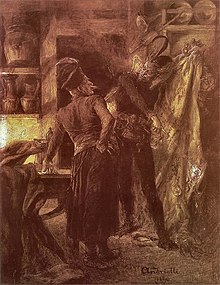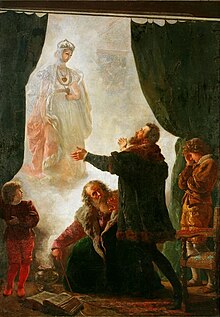Pan Twardowski

Pan Twardowski , known as Polish Faust , is the main character in dozens of Polish works that tell the story of the unusually educated Szlachcic Jan Twardowski from Krakow in different, differing variants . The core of his story is that as a Polish nobleman, he sells his soul to the devil in return for infinite power, influence and fame, and finally suffers a tragic fate.
This story shows numerous parallels to Goethe's tragedy Faust , which is based on Johann Georg Faust , who lived around the same time . It is not known whether the two stories are related.
The legend


According to legend, an unusually educated Szlachcic lived in Kraków between 1565 and 1573 , his name was Jan Twardowski . He was called Pan or Pan Twardowski , the official form of address for Polish noblemen. Twardowski spent the whole day in the study and had studied old books since his youth in order to master old age, illness and death. After decades of searching in vain for a way to attain infinitely great power, great influence and fame, one day he read an old book about how to summon the devil. He saw this as the only way to get there after all, and believed that he could easily outsmart the devil by breaking the clause in the pact with the devil, according to which the incarnate may only seize his soul in Rome - a place Twardowski never intended to visit. The unusually clever Twardowski therefore carried out everything according to the instructions in the old book, made a pact with the devil as planned, and by virtue of this contract, which made the devil subject to him, quickly received great power, fame, wealth and influence and even became a courtier at the royal court of Zygmunt II August - the king who surrounded himself with astrologers , alchemists and magicians after the death of his wife Barbara Radziwiłł .
Everything was fulfilled, whatever the demanding, imaginative Twardowski ordered: with the help of the devil, Twardowski traveled on a rooster that ran faster than a horse, Twardowski swam up the Vistula against the current and without paddling, Twardowski sent the silver from all over Poland to one Twardowski had the popularly known Czarcia Skała ('Devil's Rock') rammed into the ground with the tip and conjured up in the Ojcowski National Park below the Pieskowa Skała Castle, 30 km from Krakow, to collect the only place near Olkusz , which gave rise to the famous silver smelter near Olkusz Twardowski the ghost of the Polish Queen Barbara Radziwiłł, who died in 1551, on behalf of the grieving King Zygmunt II August. For the latter, he used the magic Twardowski mirror , which is now in Węgrów . In a disused quarry near Kraków, the devil's craft also created the Skałki Twardowskiego ("Twardowski Rocks"), which remained in Twardowski's laboratory after an explosion.
One day, when he took a liking to a virgin , he wanted to marry her. She was married to him. Pani Twardowska , his now Polish aristocratic wife, built a house out of clay on Kraków's market square. In it she sold pots and bowls. Twardowski, dressed as a rich gentleman, came riding up with a large court and ordered his entourage to smash everything. And when the woman cursed everything that was alive in her anger, he laughed loudly and happily in his splendid carriage.
The devil was tired of serving, but there was no cure for Twardowski. No remembering the date in the promissory note helped, no warning about hell - Twardowski had only one answer: "I will give you my soul, as I promised, in Rome." So the devil decided to get Twardowski's soul through a ruse. He came to Twardowski in the shape of a courtier and asked him for help for his sick master. Twardowski, greedy for praise and confirmation, quickly dressed and allowed the servant to accompany him to the sick master without anticipating any malice. The devil liked to take Twardowski to the inn, which was called no other than Rzym (Polish for Rome). No sooner had he crossed the threshold of that house than crowds of ravens, owls and eagle owls settled on the roof and filled the air with their piercing voices. Only then did Twardowski notice the inscription on the window of the inn. He immediately recognized the danger that threatened him here. In one corner of the room he noticed a cradle with a child in it. He ran to it quickly, took the child in his arms and felt safe. He knew that the devil has no right to take the child's soul. As long as he held it in his arms, he had nothing to fear. Then the devil was angry: “You are such a Szlachcic!” He shouted, “You hide behind a child and break your 'Verbum nobile' (a Szlachcic's word of honor)!” Pan Twardowski winced and gave the child back to her Cradle because the verb nobile was a sacred thing for a Szlachcic. The devil was just waiting for it. He grabbed Twardowski by the Kontusz and led him out of the inn.
While Twardowski was being led away by the devil, he suddenly began to repentfully pray to the Black Madonna of Częstochowa . This actually caused the devil to let go of his victim. Instead of going to hell , Twardowski fell on the moon, where he still lives today. Only his assistant, whom he had once turned into a spider , keeps him company, which he now temporarily lowers down to earth by a thread in order to receive news from there.
The historic Pan Twardowski
German historians suspect that the historical Pan Twardowski was originally a German nobility born in Nuremberg who studied medicine in Wittenberg before settling in Krakow in 1565. His hypothetical name Laurentius Dhur was Latinized to Durus and the formulation translated into Polish as Twardowski ( durus and twardy mean 'hard' in Latin and Polish, respectively). It is also speculated whether the legend was inspired by the life of the English mathematician, astronomer, astrologer, geographer and mystic John Dee, or the English alchemist and spiritualist Edward Kelley . Both lived in Krakow for a while.
The name Pan Twardowski led to some confusion in the 20th century because the Polish poet, religious educator and Roman Catholic priest Jan Twardowski initially bore the full name of the legendary figure and addressed him personally as Pan Twardowski (Polish: 'Herr Twardowski') always brought associations with the legendary figure, although many writers never mention the legendary figure's first name in their works.
Pan Twardowski in literature, music and film
The legend of Twardowski inspired numerous artists. However, there is - in contrast to that of Doctor Faust, which today is inextricably linked to the arrangement of Johann Wolfgang von Goethe - no "canonized" version. Thus Twardowski in Poland, unlike Faust in Germany, is still more a part of folklore than of upscale literature .
Perhaps the best-known author to take up the material is Adam Mickiewicz . In his comical ballad Pani Twardowska ("Frau Twardowski"), published in 1822, Szlachcic Twardowski escaped his fate with another trick: He refers to the condition that the devil (in this case called "Mefistofeles") before he himself Twardowski's soul can empower, has to fulfill three wishes "except for the icing on the cake". After the devil has fulfilled two seemingly impossible tasks, the hardest comes. Twardowski demands that the devil spend a year in his stead with Mrs. Twardowski in loyalty and obedience. As Twardowski suspects, the devil doesn't even wait for this test to begin and escapes through a keyhole, which saves Twardowski. Pani Twardowska was set to music by Stanisław Moniuszko in 1869 and was published as a comic in 1987 .
The motif of Pan Twardovsky also appears in some works of Russian literature , such as Alexander Nikolayevich Radishchev .
Works based on the legend
literature
- 1801: Al'oša Popovič, bogatyrskoe pesnotvorenie , poem by Alexander Nikolajewitsch Radishchev
- 1822: Pani Twardowska , ballad by Adam Mickiewicz , also as online text (Polish)
- 1840: Mistrz Twardowski ["Master Twardowski"], novel by Józef Ignacy Kraszewski (Polish) archive.org
- 18xx: Twardowski , ballad by Semen Gulak-Artemovskij
- 1861: Twardowski, the Polish Faust , a folk book by Johann Nepomuk Vogl (German) archive.org
- 1902: Mistrz Twardowski ["Master Twardowski"], poem by Leopold Staff
- 1906: Pan Twardowski , ballad by Lucjan Rydel
- 1930: Pan Twardowski, czarnoksiężnik polski ["Pan Twardowski, a Polish magician"], novel by Wacław Sieroszewski
- 1981: Pan Twardowski or The Polish Faust , a novel by Matthias Werner Krus
- 2004: Krzyż i wąż [The Cross and the Snake], story by Izabela Szolc . In: Jehannette . A collection
- 2006: Kacper Ryx , novel by Mariusz Wollny
- 2007: Królikarnia , a novel by Maciej Guzka
music
- 1822: Pan Twardowski , opera by Alexij Verstovskij
- 1869: Pani Twardowska , ballad for solos, choir and orchestra by Stanisław Moniuszko (setting of the Mickiewicz ballad of the same name )
- 1874: Pan Twardowski , ballet by Adolf Gustaw Sonnenfeld
- 1894: Twardowsky , Rhapsody by Ferdinand Pfohl based on a poem by Otto Kayser
- 1921: Pan Twardowski , ballet by Ludomir Różycki with a libretto based on the novel by Józef Ignacy Kraszewski
Movie
- 1917: Pan Twardowski , directed by Ladislas Starevitch
- 1921: Pan Twardowski , a film by Wiktor Biegański
- 1936: Pan Twardowski , a film by Henryk Szaro based on a script by Wacław Gąsiorowski
- 1995: Dzieje Mistrza Twardowskiego [“The Story of Master Twardowski”], a film by Krzysztof Gradowski based on the novel by Józef Ignacy Kraszewski
computer game
Places associated with Pan Twardowski

Pan Twardowski is believed to have lived in or near Krakow , the capital of the Kingdom of Poland at the time . Various houses in Krakow claim to be Pan Twardowski's home. The magician could just as well have lived somewhere in the city near Rynek Główny , Ulica Grodzka or in the village of Krzemionki across from the Vistula (now part of Krakow).
All over Poland there are innumerable inns with the name Rzym (Rome), all of which claim to be the locality to which the devil once led Pan Twardowski. However, the oldest of these inns is from the 17th century and was built a hundred years after Twardowski's death. The Karczma Rzym in Sucha Beskidzka is among the Twardowski localities perhaps the best known locality.
The Twardowski mirror is now in a church in Węgrów . According to a continuing legend, he showed future events to everyone who stepped before this mirror. In 1812 Napoléon Bonaparte is said to have foreseen his defeat in Russia and then damaged the mirror.
The Skałki Twardowskiego in the Skały Twardowskiego Park have become a popular destination since a lake was created around them in 1990.
Web links
- Mickiewicz and Goethe: The Devil's Pact as a literary motif . Poles at school.
- Pan Twardowski (1936). filmweb.pl
- Piotr Cielebiaś: The historical Pan Twardowski. SERWIS INFRA, July 20, 2012 (Polish)
- KARCZMA “RZYM” (Tavern “Rzym”) in Sucha Beskidzka
Individual evidence
- ↑ Hanna Widacka: Legendy i fakty o Mistrzu Twardowskim . wilanow-palac.art.pl (Polish) accessed on November 27, 2014.
- ^ Roman Bugaj: Mistrz Twardowski . wilanow-palac.art.pl Mówią wieki , nr 9, 1972 (Polish), accessed on November 27, 2014.
